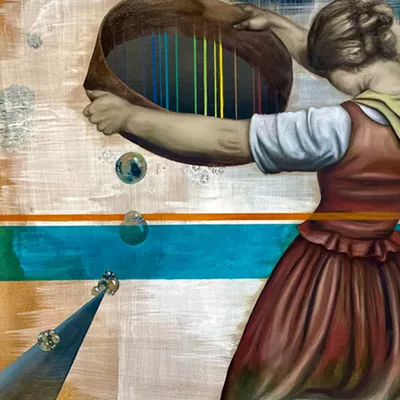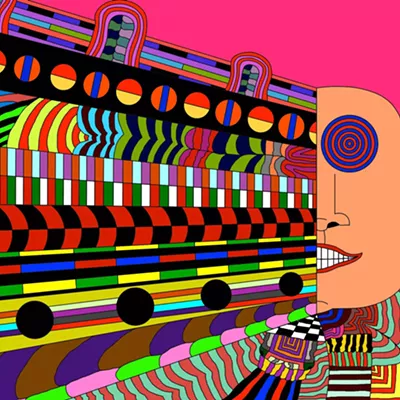
Losing control of your vehicle, especially at high speed or in tight turns, is scary. To Ryan Bourgard, it’s a stress reliever.
A soft-spoken, 29-year-old single father — his toddler daughter’s middle name is Danger, no lie — Bourgard has a wild streak. Growing up it was skateboarding and snowboarding, then autocross, singing in an alternative rock band and eventually handling sharp knives as a sushi chef.
Now it’s drifting, which is not the passive activity it sounds like. “Controlled chaos” is more like it.
On most Sundays this summer, Bourgard drives his red Toyota Corolla to Stateline Speedway and parks in the lot alongside mostly rear-wheel-drive imports like his. Out goes the car seat — and anything else that adds unnecessary weight or that he doesn’t want to lose flying around the track. On goes the helmet.
He gets into line with a dozen or so other drivers from Washington and Idaho, most 20- to 30-something amateurs like himself, although some aspire to race professionally. Bourgard cuts the engine and pushes the car, concerned about overheating on this typically scorching summer day among the black asphalt and concrete of Stateline Speedway in Post Falls. The line moves quickly as drivers follow the action on the quarter-mile, figure-eight track, cheering but also learning.
When it’s his turn, Bourgard flies up the straightaway, downshifting into the turn, flooring it, his foot working gas and brake simultaneously. The rear tires spin and lift as he yanks on the steering wheel, correcting and over-correcting to maintain the drift “line” through the turn, bracing for impact that never happens. The tires smoke, or maybe it’s the engine. A deafening sound of shrieking tires and an engine pushed to capacity. It’s over in less than a minute.
Bourgard discovered drifting last year and dug the Japanese connection. A 1990s anime film, Initial D, featured a tofu delivery boy whose high-speed touge (pronounced toe-gae), or mountain driving, popularized drifting, which is defined as “a precise balance of steering, accelerating, braking, shifting and pulling the E-brake,” according to driftingstreet.com.
Sure, it’s dangerous, but less so on the track than the streets. Theoretically.
In the first year of drifting at Stateline Speedway, only one car has ever “tapped” the wall (Nathan Shewchuk, a ballsy driver from Walla Walla) and it was intentional, says Stateline Drift (SLD) organizer Trevor Mohror.
Mohror, who drives a ’92 Nissan 240SX, has street raced since 2003 and tried other venues, including autocross, a timed, single-car event through an obstacle course. But drifting intrigued him. He approached Post Falls’ Stateline Speedway last summer about hosting events. SLD was born.
The crew includes Mohror’s girlfriend, Kara Chichester, whom he calls “the muscle” for corralling drivers and handling details, and drivers A.J. Spence and Trais Taylor. The track coordinator is general manager Larry Bertrand, formerly of Spokane County Raceway and Fast Kart Speedway.
Like Mohror, Trais has participated in Evergreen Drift, a “grassroots” event. It takes place at the track in Monroe, Wash., which is also home to round five of the seven-course Formula Drift professional season (the last race is in Irwindale, Calif., on October 12-13).
Though pro status and sponsorship might be end-goals — expenses include insurance, car maintenance and modifications, gas, entry fees and tires (lots of them) — Stateline Drift is geared toward growing the sport. Entry fees throughout the July-to-September season are $35-$45, plus insurance; $5 for spectators. Helmets, seat belts and driver attendance at the track meetings are all mandatory.
When it comes to the chosen car, though, it’s personal preference and experience. Bourgard drives a modified ’87 GTS TwinCam Toyota Corolla, an AE86 chassis called hachi-roku in Japanese, he says. It’s the same model that that tofu driver used in the anime film.
In drifting, says Bourgard, “the quickest way to gain velocity is to lose mass.” He’s dropped 500 pounds of A/C and rear seats, though the stereo is intact and bumpers are modified with zip-ties to fall off as needed.
That’s what happens to Ricky Bailey, who let me ride along on a “tandem” run, where one driver leads and others — up to five drivers — follow. Nonplussed, Bailey retrieves the bumper and drives off holding it out the window, pits briefly and lines up again.
Bailey, whose pregnant wife, Sheena, looks on from the stands, grew up in Sandpoint and got into racing through Auto Sports Northwest. A fire extinguisher tech for Oxarc, Bailey modified his everyday Nissan with a Japanese SSR 20 Turbo engine. To get to the next level, says Bailey nodding at Trais Taylor’s car, he’ll need something even better.
Better costs money. An office supply salesman by day, driver Cody Hall is into his Nissan 240SX for around $8,000, including motor, suspension, roll cage and flat black paint.
Like drag racers and hot rodders before them, drift drivers have gotten resourceful, forming social networks to swap parts and information in equal measure. Although SLD’s season ended last week, track attendance and participation was steady this year. And the group’s Facebook page (stateline.drift), counts 400 followers — fans, yes, but also potential future drivers in this growing sport.
That’s good news for Mohror, who is already planning for next season. “Everyone likes to do burnouts,” he says.
Catch the season’s highlights on NBC Sports’ first-ever Formula Drift broadcast, starting September 2 and continuing every Sunday at 2 pm through December 2.
For local action, check out stateline.drift on Facebook.


















